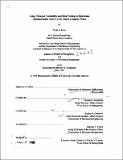| dc.contributor.advisor | Donald B. Rosenfield and Stanley B. Gershwin. | en_US |
| dc.contributor.author | Roza, Scott A. (Scott Allen), 1968- | en_US |
| dc.contributor.other | Leaders for Manufacturing Program. | en_US |
| dc.date.accessioned | 2010-10-05T14:31:40Z | |
| dc.date.available | 2010-10-05T14:31:40Z | |
| dc.date.copyright | 1998 | en_US |
| dc.date.issued | 1998 | en_US |
| dc.identifier.uri | http://hdl.handle.net/1721.1/58865 | |
| dc.description | Thesis (M.B.A.)--Massachusetts Institute of Technology, Sloan School of Management; and, (S.M.)--Massachusetts Institute of Technology, Dept. of Mechanical Engineering; in conjunction with the Leaders for Manufacturing Program at MIT, 1998. | en_US |
| dc.description | Includes bibliographical references (p. 55-56). | en_US |
| dc.description.abstract | Bay Networks, like other high tech companies whose competitive advantage lies in the design of their products, has moved to a manufacturing model that relies heavily on outsourcing. Almost all the components of its products, from metal boxes and power supplies, to electronic components and the printed circuit boards on which they reside, are manufactured and assembled by subcontractors. This strategy has been pursued to reduce costs and to increase flexibility. To make this system work effectively, considering the long lead times sometimes associated with networking electronic components, Bay Networks forecasts demand to eliminate a portion of the demand uncertainty. Bay then passes its forecast to the subcontractors so they can deliver material as Bay expects to use it. This model makes the forecasting function of extreme importance when determining whether Bay will end up with too much or too little material. This thesis analyzes the "outsourced" supply chain that Bay Networks currently uses and how forecasting is really the cornerstone of information dissemination within the supply chain. Additionally, this thesis will look very specifically at how demand for the motherboard of a particular networking product is forecast and how it is an example of taking outsourcing too far. Since Bay Networks is forecasting motherboards with a specific memory configuration, before they actually know what the customer wants for memory, they are reworking many boards to effectively meet customer demand. Further analysis will show that forecasting motherboards in the plain vanilla format, i.e. without memory, and configuring with memory only when they receive a customer order, will allow Bay Networks to take advantage of the concept of risk-pooling. With risk-pooling Bay Networks will be able to increase customer service levels with less inventory- a win -win situation considering that the typical tradeoff consists of increasing inventory to improve service levels. Specifically, it will be shown that the optimal level of inventory safety stock for these and other motherboards can be significantly reduced by holding them in a format which allows them to be easily and flexibly configured to satisfy demand when a customer order arrives rather than holding the material in a specific format. | en_US |
| dc.description.statementofresponsibility | by Scott A. Roza. | en_US |
| dc.format.extent | 56 p. | en_US |
| dc.language.iso | eng | en_US |
| dc.publisher | Massachusetts Institute of Technology | en_US |
| dc.rights | M.I.T. theses are protected by
copyright. They may be viewed from this source for any purpose, but
reproduction or distribution in any format is prohibited without written
permission. See provided URL for inquiries about permission. | en_US |
| dc.rights.uri | http://dspace.mit.edu/handle/1721.1/7582 | en_US |
| dc.subject | Sloan School of Management. | en_US |
| dc.subject | Mechanical Engineering. | en_US |
| dc.subject | Leaders for Manufacturing Program. | en_US |
| dc.title | Using forecast variability and risk pooling to determine optimal safety stock levels within a supply chain | en_US |
| dc.type | Thesis | en_US |
| dc.description.degree | S.M. | en_US |
| dc.description.degree | M.B.A. | en_US |
| dc.contributor.department | Leaders for Manufacturing Program at MIT | en_US |
| dc.contributor.department | Massachusetts Institute of Technology. Department of Mechanical Engineering | |
| dc.contributor.department | Sloan School of Management | |
| dc.identifier.oclc | 48214754 | en_US |
